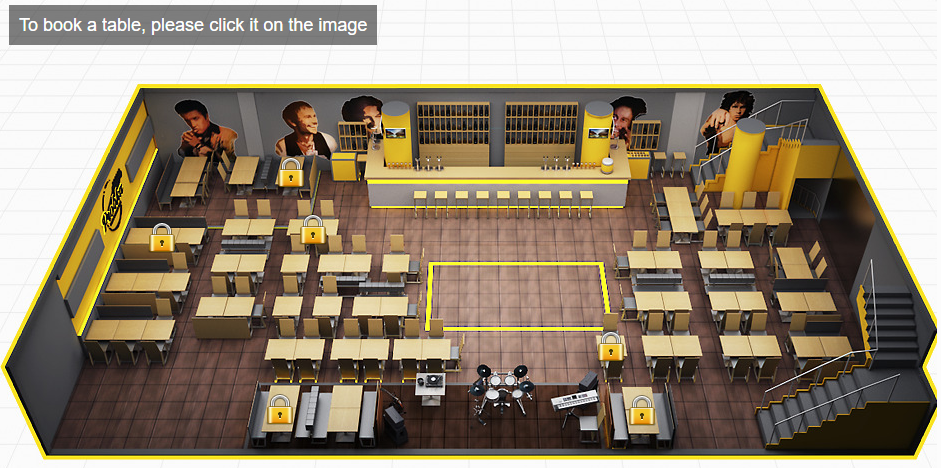The Button
OpenTable – an online restaurant table booking startup was successful in the US in 2011. Daniel Tonkopiy wanted to bring the same idea to Ukraine.
He and his team built a CRM reservation backend. But the more exciting innovation was a 3-D interactive image of each restaurant. This allowed customers to get a feel for the place and pick the seating visually, by clicking on the seat they wanted. A one button booking system.

This took a year of work.
They earned only $1 per reservation. So they needed scale to make any money. They got only 4 bookings in the first week of launch. Such a sophisticated product. But consumers preferred paper, pen and phone.
There was no market. They failed.
Door Dash
In 2013, Door Dash cobbled together a landing page on PaloAltoDelivery.com. A collection of PDF menus from the Palo Alto neighborhood.
45 minutes after their website launched, they received their first order. The founders (Stanford students), jumped into a car, picked up the order, and delivered it.
Next day they got 2 more calls, 5 the day after, then 7, and then 10.
Door Dash went for an IPO in Dec 2020 at $72bio valuation.
Product market fit
When a product fills the need shaped holes in a consumer’s life, we have product market fit.
The happy irony is that if we have product market fit, we don’t need marketing, or even a polished product. Consumers spread the word, happily wait in line, and even overlook mistakes.
Most Silicon Valley startups are founded by engineers. They love to tinker with technologies, so end up with a product before they have a market. They believe, ‘if I make it, customers will come’.
Not true.
In fact, this report from cbinsights shows ‘no market need’ to be the biggest reason for new company failure.

Founders of consumer good companies were like the software engineers of today. They were chemists, doctors and engineers, who loved to tinker with new products and were lucky enough to find a market.
- Henri Nestle was a pharmacist, and he developed a mixture of milk, wheat and sugar for malnourished kids. Nestle was born.
- Eugene Schueller, a chemist developed a hair dye, that he sold to Parisian hair dressers. L’Oreal was born.
- John Pemberton was a chemist. He invented a coca wine containing alcohol, to help him with his morphine addiction. During the prohibition he removed the alcohol from the drink and called it Coca-Cola.
The journey from a good product to a great market does not happen instantly. For most consumer goods companies, it has taken 100+ years.
The truth is that either the product or the customer base – often both, have to be tweaked multiple times to get to success.
These tweaks are called pivots.
Pivots
Business world is bursting with stories of smart pivots that got start ups to success. Here are three.
- Instagram used to be Burbn – a location-based social network, with an an optional photo feature. Its users were only using the photos and filters. Burbn pivoted to Instagram – the best app for posting photos with filters.
- Play-Doh used to be Kutol – a material to clean the black coal residue from walls. As electric heating replaced coal, this material was relaunched as multi color modeling clay – pay doh.
- William Wrigley Jr. was a soap salesman. He used to give free chewing gum to his customers. The gum was more popular than his soap. He started manufacturing his own gum and created world famous chewing gum brands.
Early proof and hustle
Before the pivot comes the hustle.
The smartest founders get early proof of product market fit. Sophisticated PE funds call this MVP (minimum viable product) ;-). I call it hustle.
Innocent Drinks was started at a music festival. The founders put up a sign asking people to vote with their empty bottles into bins labeled ‘Yes’ or ‘No’ to whether they should give up their jobs to make smoothies. The ‘Yes’ bin was full. The founders quit their jobs the next day and started Innocent Drinks.
Zappos started like Door Dash, as a hustle. Nick Swinmurn, was not sure if people would buy shoes online. He went to a few stores, took pictures of some shoes. Made a basic website with those pictures. When he got orders, he bought the shoes at full price and shipped them out.
Sexy story is not product
Consumer marketers tend to fall into a trap of spending a lot of time and money trying to get advertising market fit, instead of product market fit. We think that simply making a great ad will get us a sustainable business.

We forget the most fundamental rule – the product has to fill need shaped holes in the consumer’s life. Sexy stories about bad products won’t get us far.
We are products too
Food for thought for me is:
1) we are all ‘products’, are we in the best market for us as professionals?
2) are we relying only on sexy stories to get by instead of perfecting our product?
3) are we continuing to pivot our product to go from a good product to a great one?
4) are we hustling some early proof as we pivot?
Unicorns and Phool
Since this newsletter is about startups. I am reminded of the essay I have written on Phool (flower) – an Indian startup. They did not start with a product, but with a problem – prayer flowers polluting The Holy Ganges.
They invented flower-cycling – converting prayer flowers into incense sticks. After initial success, Phool’s research department is inventing more uses for recycled flowers, like vegan leather and styrofoam.
The essay explores which product line has the potential to make Phool a unicorn. Check it out here.
